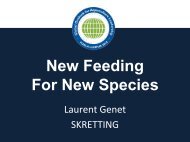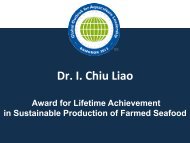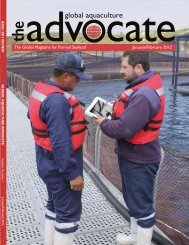May/June 2010 - Global Aquaculture Alliance
May/June 2010 - Global Aquaculture Alliance
May/June 2010 - Global Aquaculture Alliance
Create successful ePaper yourself
Turn your PDF publications into a flip-book with our unique Google optimized e-Paper software.
innovation<br />
SPF Shrimp Breeding In Brazil<br />
Genetic, Phenotypic Trends After Generation Of Selection<br />
Technicians weighed test shrimp at this work station.<br />
João L. Rocha, Ph.D.<br />
Genearch Aquacultura Lda.<br />
Praia de Pititinga<br />
RN, CEP 59578 Brazil<br />
johnrocha@genearch.com.br<br />
Ana C. Guerrelhas<br />
Ana K. Teixeira<br />
Flávio A. Farias<br />
Ana P. Teixeira<br />
Genearch Aquacultura Lda.<br />
Summary:<br />
Through a genetic selection program started in 2006,<br />
significant advances have been achieved in the development<br />
of a specific pathogen-fee L. vannamei line in<br />
Brazil. These shrimp have performed well under high<br />
densities in intensive production systems. In tests, some<br />
animals stocked at 167.5 shrimp/m 2 had average weekly<br />
growth of 1.516 g and harvested biomass of 2.64 kg/m 2 .<br />
This research represents significant support for Brazil’s<br />
shrimp-farming industry.<br />
Genearch Aquacultura, a Brazilian shrimp-breeding company<br />
associated with Aquatec, the leading commercial hatchery<br />
in the country, initiated the specific pathogen-free (SPF) era in<br />
Brazil with SPF Litopenaeus vannamei imports in 2006. After a<br />
series of comprehensive commercial field<br />
tests in ponds under local conditions, the<br />
genetic format to be adopted by the<br />
incipient breeding program was defined,<br />
and a program was initiated.<br />
Genetic Improvement<br />
From the series of four preliminary<br />
field tests, it was concluded that the best<br />
course for the Genearch SPF genetic<br />
improvement program would be the constitution<br />
of a synthetic/composite SPF<br />
population bringing together contributions<br />
from all six SPF founder populations.<br />
The founders have been separately<br />
perpetuated and maintained alongside the<br />
main breeding and selection program for<br />
purposes of genetic variability preservation.<br />
One genetic batch of 60 full-sib families<br />
is produced every three months with a<br />
total of 240 full-sib families produced every<br />
year. Some 500 to 600 tagged animals are<br />
stocked per family in the genetic nucleus<br />
(G.N.) performance tests, and 150 animals/family<br />
are stocked in a pond field test conducted with every<br />
batch. The field tests are managed under commercial conditions<br />
that reflect the prevailing shrimp production realities in Brazil.<br />
The selection program includes family selection based on a<br />
selection index combining G.N. and field test genetic merit estimates<br />
for growth and survival. Within-family selection for<br />
growth in the G.N. tests in the breeding center – in a biofloc<br />
system at stocking densities of 100-150 shrimp/m2 mals/family are stocked in a pond field test conducted with every<br />
– are also<br />
considered.<br />
Family identification is through elastomer tagging when animals<br />
reach the 2-g juvenile stage. Best linear unbiased prediction<br />
(BLUP) methods are used to statistically examine random effects<br />
in linear mixed models.<br />
Results<br />
The first genetic batch was produced in 2007. The first three<br />
batches were first-generation batches derived from crosses among<br />
the different SPF founder populations. Batches 2 and 3 were considered<br />
to belong to generation 1.5 in Figures 3 to 6, and batches<br />
4 through 7 were second-generation, already reflecting one generation<br />
of family and within-family selection for growth and survival.<br />
Batches 6 and 7 belong to generation 2.5 in Figures 3 to 6.<br />
The performance tests for batch 7 were recently evaluated.<br />
After one generation and four batches of index selection<br />
combining G.N. and field test genetic merit estimates for<br />
growth and survival, it became clear that moderately strong<br />
genetic/environment interactions between the G.N. and field<br />
test environments played an important and unfortunate role, as<br />
well as mildly antagonistic correlations between growth and survival<br />
in the field test environment.<br />
Both realities negatively impacted expected genetic improvement<br />
rates, especially for the field test environment. The establishment<br />
of two separate breeding lines was therefore recommended.<br />
One line targeted the current commercial environment in<br />
Brazil: low stocking densities under 40 shrimp/m 2 and reduced<br />
levels of management in usually large ponds. The other line targeted<br />
more intensive systems stocked at densities of 100-200<br />
shrimp/m 2 under higher levels of management. The latter systems<br />
are scarce in Brazil, but could become more important in<br />
the future.<br />
Trends<br />
Genetic and phenotypic trends registered for the G.N. environment<br />
traits in the SPF breeding program after four batches<br />
and one generation of selection are shown in Figures 1 to 6. Due<br />
to the previously mentioned genetic and environmental (G x E)<br />
interactions between the G.N. and field test environments, the<br />
BLUP estimates for the first-generation average genetic gain<br />
rates obtained for the G.N. growth traits were lower than<br />
expected (Figure 1 – 5.3 and 6.6% of the mean harvest weight<br />
and weekly growth, respectively). However, the situation will be<br />
corrected with the establishment of two separate lines, each targeting<br />
one of the two different environments.<br />
This conclusion was validated by the reasonable genetic gain<br />
rates obtained in the second-generation batch 6, derived from the<br />
family selections implemented in batch 2 (Figures 1 and 2). By<br />
chance, it was not possible to conduct a field test for batch 2, so its<br />
family selections were not impacted by G x E interactions. Batch 2<br />
family selections reflected the G.N. performance test results.<br />
The genetic gains obtained for the G.N. growth traits in<br />
batch 6 were fairly good (8.6 and 10.4% of the mean harvest<br />
weight and weekly growth, respectively), and very close to the<br />
theoretical expectations for a program with the characteristics<br />
and scale of Genearch’s breeding program. The G x E interactions<br />
were mainly responsible for the low average genetic gain<br />
Figure 1. Genetic trend: Weekly growth of seven batches of shrimp.<br />
80 <strong>May</strong>/<strong>June</strong> <strong>2010</strong> global aquaculture advocate global aquaculture advocate <strong>May</strong>/<strong>June</strong> <strong>2010</strong> 81<br />
Growth (g/week)<br />
0.10<br />
0.06<br />
0.02<br />
-0.02<br />
-0.06<br />
-0.10<br />
0.010<br />
0.005<br />
0<br />
-0.005<br />
-0.010<br />
Generation 1 Generation 2<br />
Batches 1-4 Batches 1-5 Batches 2-6 Batches 3-7<br />
Generation 1 Generation 2<br />
Batches 1-4 Batches 1-5 Batches 2-6 Batches 3-7<br />
Figure 2. Genetic trend: Survival of seven batches of shrimp.





